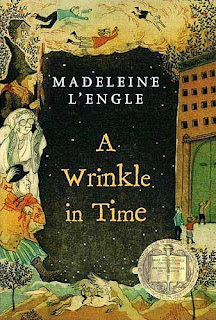It is always unsettling when you don't much care for a book that has been praised to the heavens. It obviously reflects on you because everyone else seems to have liked it. I remember a friend telling me she didn't like Philip Pullman's The Golden Compass. Judgement washed over me like a ten foot wave and am sure the same happens to others when I tell them I could never get through, God of Small Things (Arundhati Roy), Fountain Head ( Ayn Rand ) and of course the most sacrilegious of all, The Catcher in the Rye.
A Wrinkle in Time is a young adult science fiction novel that was written by Madeleine L'Engle in the 1960's. It is an extremely popular american young adult novel and is a subscribed reading text for high school. I am in the middle of a Young Adult reading phase, 'research' is what I call it. What it is is a shameless way to spend weekdays reading books- my favourite part of the novel writing process. A Wrinkle In Time was part of a 'must read' young adult list.
A Wrinkle in Time is a young adult science fiction novel that was written by Madeleine L'Engle in the 1960's. It is an extremely popular american young adult novel and is a subscribed reading text for high school. I am in the middle of a Young Adult reading phase, 'research' is what I call it. What it is is a shameless way to spend weekdays reading books- my favourite part of the novel writing process. A Wrinkle In Time was part of a 'must read' young adult list.
The book tells the story of Meg, her little brother Charles Wallace and a new friend Calvin and their search for Meg's father. The book has a rather promising start. We find Meg, her extremely intuitive brother Charles Wallace, two little twins and a beautiful mother stuck in a small town still reeling from the sudden untimely departure of their beloved father and husband. Meg is awkward, her brother far too intuitive for his own good and their mother who happens to be living in a bubble of denial. One day three old women sweep into their lives and take them on a journey to bring their father back, one that will lead them through multiple planets through the universe to fight 'The Black Thing' that is somehow connected to her father and the future of the earth.
It is no doubt an intelligent novel that is very much a product of its time. The 1960's was a torch bearer for space exploration and also the cold war which in its heart was the fight against communism which is probably what 'The Black Thing' refers to. The main theme is about the triumph of individuality and the debilitating nature of sameness which is not similar to oneness or equality. The Black Thing seeks to remove all creativity and individuality from the universe. The argument is that sameness keeps order and leads to no disease or sadness. But without sadness there is no joy or love. And therefore love, is what sets everything free in the story.
With regards to science, it uses much of the modern quantum theory to support the story. The concept of pinching the folds of the universe to jump through it is quite ingenious and I think I will be using the tesseract image before long. The worlds themselves are marvellous and Madeleine L'Engle's writing is extremely compelling and never contrived, which is so much the problem with fantasy these days. So essentially we have a beautiful story of the zeitgeist of the time. So what's wrong?
All three children were insufferable. I found Meg infuriatingly smug, Charles Wallace a young know it all and Calvin, insipid. The only saving grace, or rather three of them came in the form of the three old women, Mrs Whatsit, Mrs Which, and Mrs Who who act like fairy godmothers. The author has created three wonderful children's characters and I am sure they are the reason why the book was so successful. Perhaps if Meg hadn't been such a winger the book would have a winner.
Next Week: Go Ask Alice!
Next Week: Go Ask Alice!

No comments:
Post a Comment